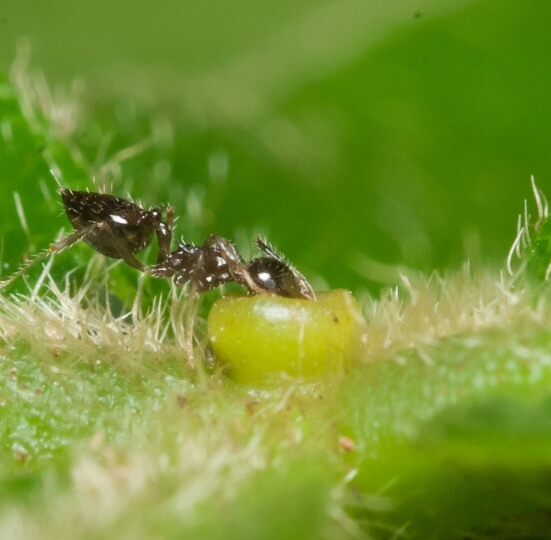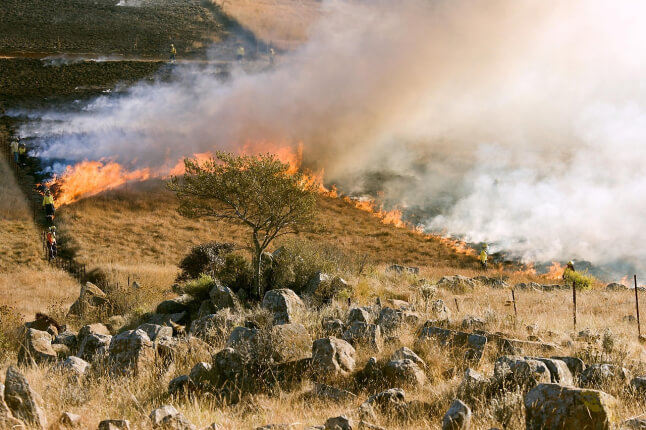News
An acrobat ant (Crematogaster sp.) feeding at a bowl-shaped extrafloral nectary on an Inga tree (Lauren Nichols/NC State University)
A multidisciplinary team of scientists and chefs has taken a fresh look at a food-making phenomena observed across plant, animal, and fungi species, in which one organism produces food to feed (or deceive) another individual.
These “nature’s chefs” give food to other individuals to increase their own evolutionary fitness, yet across an array of species – including humans – the researchers have found that catering for someone or something else generally either has direct reproductive or nutritional value. These findings, the first attempt at discovering what it means universally to prepare food for another organism, were published in BioScience.
“We are very excited by this unifying idea that, across species and taxonomic groups, organisms that prepare food for others tend to cater to their consumers in similar ways,” says Pia Sörensen, a senior author on the paper, who is a senior preceptor at Harvard’s John A. Paulson School of Engineering and Applied Sciences (SEAS) and an expert and instructor in the intersection of science and food.
“The genesis of the idea for nature’s chefs occurred at an interdisciplinary gathering” – a conference called Talking Sense – “when, in response to an explanation of the evolution of fruits, a chef uttered ‘You mean to say, fruits are nature’s chefs,’” says coauthor and ecologist Rob Dunn of North Carolina State University (NCSU), according to a press release.
“There are many ways of classifying species interactions,” says NCSU ecologist Brad Taylor, corresponding author. “But the ‘nature’s chef’ concept spans members of all these groups, with the common factor being that the relevant interactions all rely on food – or the lure of food.”
“These processes – across all known major life forms – have never before been considered altogether,” says Sörensen. “There’s been research on foods, drinks, and lures, papers published on different types of nectars comparing them to mixology, but from a scientific standpoint all of nature’s chefs have not been considered collectively. There are important insights to draw from looking at this concept widely.”
By comprehensively studying scientific literature from a range of disciplines, the team found evidence that nature’s chefs have evolved to prepare meals for others, or to prepare items that deceptively look like food or prey, to boost their own survival and that of their offspring.
Some plants, for example, lure insects and animals to dine on fleshy fruit. In doing so, their seeds are carried far away and dispersed broadly. Meanwhile, carnivorous plants attract insects with sugar substances, only to trap and devour them.
“Parallel to human chefs, nature’s chefs advertise their food through arrangement, color, scent,” Sörensen says. Some flowers use color and shape to catch the attention of certain insects and birds. Similarly, psychology researchers have found that human diners prefer abstract and colorful arrangements of food.
“All chefs must also make the best use of available ingredients. Whereas human chefs might be limited by regionally-available produce, nature’s chefs might be limited by the amount of nitrogen in the environment,” she adds. “Some haute cuisine chefs even deliberately limit themselves to local ingredients as a means of pushing themselves creatively.” Take, for example, Virgilio Martinez, a chef who makes use of Peru’s high-altitude cyanobacteria in some of his dishes, or Nordic chefs who use local gooseberries for acidity rather than importing lemons.
In general, “nature has at its disposal the same materials and molecules as human chefs,” Sörensen says, which food-makers use to tune their culinary creations. Certain flowers produce thicker nectars to attract insects that feed by sticking their mouth parts into the syrup. Meanwhile, other flowers produce thinner nectars, attracting hummingbirds and butterflies that slurp up a sugary meal using straw-like tongues. In SEAS’s Science and Cooking course, Sörensen says “the science of sugar is a classic topic often covered by Boston pastry chef Joanne Chang,” who is behind the city’s popular Flour Bakery locations.
Sörensen, who specializes in fermentation processes, further points out that both humans and nature’s chefs sometimes cook with heat. Bees, for instance, produce heat to raise the temperature inside their honey-making hives.
Importantly, the researchers found that nature’s chefs must get a net benefit by expending energy and resources to prepare food for others. Otherwise, it would not be worth it from a survival standpoint.
“The idea with all this is that there’s always a benefit to the chef, but there may not always be a benefit to the consumer,” Sörensen says.
Nabila Rodríguez Valerón – a Ph.D. student in Sörensen’s lab and an R&D researcher at Copenhagen restaurant Alchemist, a Michelin-starred restaurant that’s been described as the world’s most creative restaurant – and Sörensen hope this study could inspire new creativity for chefs and the food industry, such as looking at plant or fungi flesh that mimic the taste or smell of meat to see if those insights could be adapted to produce new meat-free food alternatives for people.
Additional authors on the paper include Bradley Allf, Skylar R. Hopkins, Rebecca E. Irwin, Michelle Jewell, Omer Nevo, Lauren M. Nichols, and Joshua D. Evans.
Learn more about “nature’s chefs” by listening to a recent BioScience Talks podcast episode featuring Sörensen.
Topics: Cooking, Environment, Environmental Science & Engineering
Cutting-edge science delivered direct to your inbox.
Join the Harvard SEAS mailing list.
Press Contact
Paul Karoff



